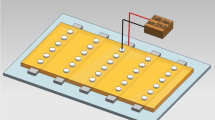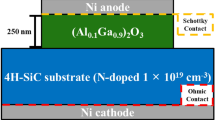Abstract
Ultra-thin epitaxial CoSi2 films formed by Co(3∼5nm)/Ti(1 nm)/Si(100) and Co(3∼5nm)/Si(lnm)/Ti(Inm)/Si are studied. The multilayers are deposited by ion-beam sputtering. Rapid thermal annealing (RTA) is used for silicidation. XRD, RBS, TEM, AFM, four-point probe, I-V and C-V measurements are carried out for characterization. The XRD spectra show the CoSi2 film formed by Co/Ti/Si or Co/Si/Ti/Si solid phase epitaxy has, epitaxial characteristic. XTEM shows that the film is continuous. RBS/Channeling shows that the formed CoSi2 has sharp interface with a minimum channeling yield of Co signal of 40%. AFM shows that the surface of ultra-thin CoSi2 film is smooth with a roughness of nearly 0.7 nm. The Rs∼T relationship shows that the CoSi2 films formed by Co/Si/Ti/Si reaction have the best thermal stability (stable up to 900°C). Those formed by Co/Ti/Si reaction are stable up to 850°C, while those formed by Co/Si reaction are only stable up to 750°C. By fitting the experimental I-V and C-V curves of the epitaxial CoSi2/Si Schottky diodes, barrier heights of around 0.6 eV and close to unity ideality factors are obtained.
Similar content being viewed by others
References
B.A. Vojak, G.A. Alley, IEEE Electron device, ED-30, 877 (1983).
Z.G. **ao, G.A. Rozgonyi, C.A. Canovai, C.M. Osburn, J. Mater. Res. 7, 269 (1992).
W.P. Maszara, Appl. Phys. Lett. 62, 961 (1993).
R.T. Tung, Mater. Chem. Phys. 32, 107 (1993).
A.E. White, K.T. Short, R.C. Dynes, J.P. Garno, J.M. Gibson, Appl. Phys. Lett. 50, 95 (1987).
R.T. Tung, Appl. Surf. Sci. 117/118, 268 (1997).
R.T. Tung, F. Schrey, MRS Symp. Proc. 402, 173 (1996).
M.L.A. Dass, D.B. Fraser, C.-S. Wei, Appl. Phys. Lett. 58, 1308 (1991).
P. Liu, B.-Z. Li, Z. Sun Z.G. Gu, W.N. Huang, Z.Z. Zhou, R.S. Ni, C.L Lin, S.C. Zhou, F. Hong, G.A. Rozgonyi, J. Appl. Phys. 74, 1700 (1993).
A. Lawers, K. Kyllesbech Larsen, M. Van Hove, R. Verbeeck, K. Maex, M. Von Rossum, J. Appl. Phys. 77, 2525 (1995).
S. Hatzikonstantindou, P. Wikman, S.L. Zhang, C. Sture Petersson, J. Appl. Phys. 80, 252 (1996).
J. Cardenas, S.L. Zhang, B.G. Svensson, C.S. Petersson, J. Appl. Phys. 80, 762 (1996).
Author information
Authors and Affiliations
Corresponding author
Rights and permissions
About this article
Cite this article
Qu, XP., Ru, GP., Li, BZ. et al. Formation and Characterization of Spe Grown Ultra-Thin Cobalt Disilicide Film. MRS Online Proceedings Library 564, 157–162 (1999). https://doi.org/10.1557/PROC-564-157
Published:
Issue Date:
DOI: https://doi.org/10.1557/PROC-564-157




